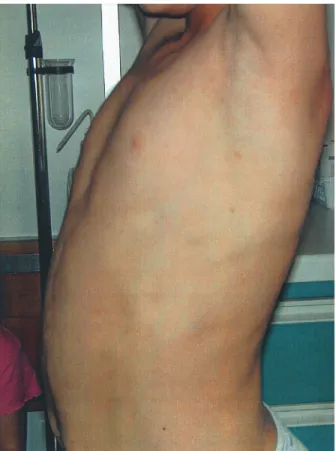The child with initially refractory skin infection after renal transplantation
Texte intégral
(2) 928. M. J. Kemper et al.. Fig. 2. Aggravation despite intensive local therapy.. Fig. 3. Complete healing after switching mycophenolate mofetil to azathioprine.. 3 months and did not recur (Figure 3). Renal function remained stable and no further pneumonia occurred.. lesions. This suggests a causal role for MMF in the development of MC.. Discussion. Teaching point. Infectious complications are the price of effective immunosuppression leading to long-term graft survival of kidney transplantation especially in childhood. With immunosuppression viral infections can cause systemic and life-threatening infections (e.g. CMV and EBV ). Viruses, however, can also lead to skin disease. In children after transplantation these most frequently include warts, herpes simplexuzoster, and in up to 6.9% MC w1,2x. Most of these lesions are not life threatening but can cause significant morbidity, cosmetic problems, and may compromise quality of life considerably w3x. Usually MC can be treated easily by cryotherapy in immunocompetent children, however, in our patient, development of extensive lesions could not be controlled by external measures. Reduction of calcineurin inhibition was unsuccessful. Only after switching mycophenolate to azathioprine, did external treatment result in complete healing of. In a patient on immunosuppression treatment, refractory skin infections such as MC can cause significant morbidity. While external treatment alone may be insufficient, additional modification of immunosuppression may be necessary to achieve complete healing.. References 1. Euvrard S, Kanitakis J, Cochat P, Cambazard F, Claudy A. Skin diseases in children with organ transplants. J Am Acad Dermatol 2001; 44: 932–939 2. Taskapan O, Yenicesu M, Aksu A. A giant solitary molluscum contagiosum, resembling nodular basal cell carcinoma, in a renal transplant recipient. Acta Derm Venereol 1996; 76: 247–2488 3. Au WY, Lie AK, Shek TW. Fulminant molluscum contagiosum infection and concomitant leukaemia cutis after bone marrow transplantation for chronic myeloid leukaemia. Br J Dermatol 2000; 143: 1097–1098.
(3)
Figure

Documents relatifs
Des études contrôlées sont donc nécessaires, tant pour caractériser le profil de perte osseuse chez les enfants atteints d’une maladie chronique que pour éva- luer l’efficacité
Les résultats de cette étude semblent indiquer qu’il faudrait traiter 7 femmes pendant plus d’une année avec des œstrogènes pour diminuer le risque d’apparition de la
The article focuses on the organisation of the Linux traffic controller to investigate, over a classical Ethernet (wired) link, two typical properties of the air interface of an
Les pressions systolique et diastolique sont mesurées au début de l'examen au niveau de l'artère à l'aide d'un sphygmomanomètre à mercure et servent pour l'étalon- nage par la
- Actes de la table ronde internationale « Vers une standardisation de l’écriture berbère (tarifit) : implications théoriques et solutions pratiques - Université
[r]